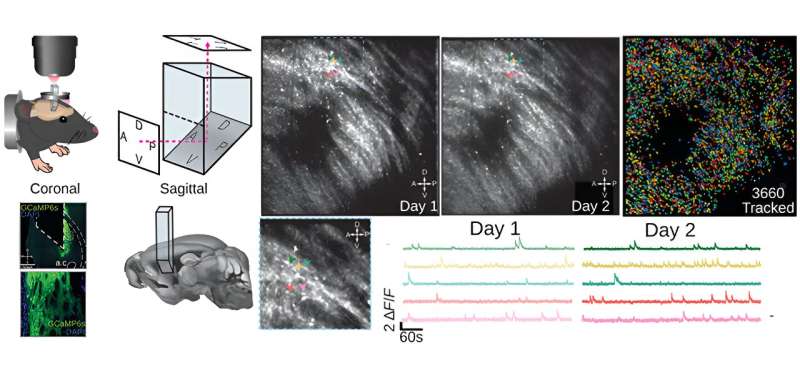This article has been reviewed according to Science X's editorial process and policies. Editors have highlighted the following attributes while ensuring the content's credibility:
fact-checked
trusted source
proofread
Team develops method for imaging deep brain activity with microprisms

Organisms constantly face the challenge of adapting their behavior to survive in a world full of uncertainties. This ability relies on complex neural circuits in the brain that help them find resources while avoiding danger. Scientists study how these neural circuits change over time to understand better how behaviors emerge.
One powerful way to study these changes is through optical imaging techniques that allow researchers to track the activity of individual brain cells. Traditional methods rely on observing the activity of cells directly, but this can be difficult when the activity patterns change over time. To overcome this challenge, researchers use techniques like fluorescence microscopy, which relies on special indicators that light up when cells are active.
A popular indicator used in this type of research is GCaMP, which lights up in response to calcium influx in the cells. Since calcium levels rise when neurons fire, GCaMP provides a useful way to track neural activity. By averaging the fluorescence over time, researchers can create a map showing where activity is happening in the brain.
These indicators can be excited using different types of light, with multiphoton imaging being particularly useful for capturing clear images of cells. However, multiphoton imaging has limitations, such as its shallow penetration depth into the brain, which restricts visualization to the outer layers of the cortex.
To overcome this limitation, researchers have developed techniques like using gradient-index (GRIN) lenses implanted in the brain to allow deeper imaging. These lenses focus light deep into the brain, enabling researchers to track activity in regions that were previously inaccessible. However, GRIN lenses have their drawbacks, including non-uniform imaging and distortion of cell morphology.
An alternative approach to calcium imaging involves using microprisms, which offer more uniform imaging but require specialized equipment to visualize deeper brain structures. Recent advances in microscope objectives have made it possible to use microprisms for imaging subcortical regions, opening new possibilities for research.
As reported in Neurophotonics, researchers at the University of Washington have developed a protocol for using microprisms to image deep brain regions, allowing them to track neuronal activity over multiple days with high resolution and throughput.
According to corresponding author Professor Garret D. Stuber, "This approach represents a significant advancement in our ability to study how neural circuits evolve over time."
By using techniques like fluorescence microscopy and innovative tools like microprisms, scientists are gaining new insights into how the brain adapts and changes over time. These advances are crucial for understanding fundamental processes underlying behavior and cognition.
More information: Madelyn M. Hjort et al, Microprisms enable enhanced throughput and resolution for longitudinal tracking of neuronal ensembles in deep brain structures, Neurophotonics (2024). DOI: 10.1117/1.NPh.11.3.033407



















